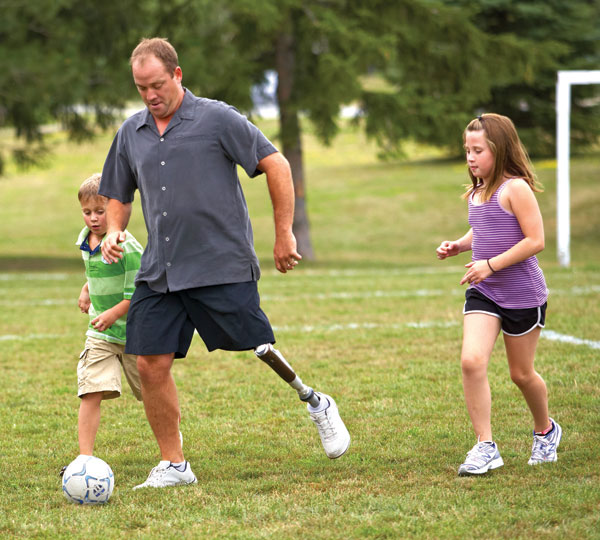The Bionic Man Is Real!

The freak accident that upended John Voelpel’s life happened so fast he barely had time to react. As the attorney drove to Tampa, Florida, to have dinner with friends, an intoxicated driver—a speed demon doing 85 in a 45 mile-per-hour zone—slammed into his car head-on. Despite the shock of the collision, Voelpel’s prognosis didn’t look so bad initially: He’d sustained a compound fracture in his right foot. He anticipated a gradual recovery, but complications kept getting in the way. “I developed a bone infection as a result of the compound fracture, and I never got extension in my knee after months in physical therapy,” he says. “I decided it was time to get on with life.” His doctors agreed, and they amputated his right leg above the knee.
After Voelpel recovered from his operation, he learned to use a prosthesis called the C-Leg from German manufacturer Otto Bock. While it was functional enough to get him from place to place, it never really felt like part of his own body. So when University of South Florida (USF) physical therapist Jason Highsmith invited Voelpel to enter trials of the Genium—an Otto Bock leg with a new microprocessor-controlled knee—he readily signed up.
Voelpel wasn’t sure what to expect when he showed up at USF for his Genium-powered leg. But as he maneuvered through a series of everyday tasks in the lab, including walking on level and inclined surfaces, loading washers, and carrying groceries up and down stairs, he started to realize just how responsive his new knee was. Not only was he able to ascend stairs, something he’d never been able to do with the C-Leg, he could walk comfortably on uneven terrain.
Voelpel’s newfound mobility got him thinking about a level of activity that would have been inconceivable before. Like hiking a steep forest trail, taking an overnight backpacking trip—so many options! “In terms of matching the natural gait and rhythm of my sound left leg, the Genium is at least twice as good as the C-Leg,” he says. “It has truly made a wonderful improvement in my life.”
When Luke Skywalker donned a cybernetic hand in The Empire Strikes Back to replace the limb he’d lost in a duel with Darth Vader, fully functional prostheses seemed squarely in the realm of science fiction, and would remain there for quite some time. As recently as 2009, inventor Dean Kamen recalled what a senior military surgeon had told him years before: “At the end of the Civil War, they were shooting each other with muskets. If somebody lost an arm, we gave them a wooden stick with a hook on it. Now, we’ve got F18s and F22s, and if somebody loses an arm we give them a plastic stick with a hook on it.”
In the past few years, though, prosthetic technology has progressed far beyond simple stick-and-hook designs. The newest prostheses, both commercial and experimental, closely mimic natural limbs in function and responsiveness, and they’re proving their worth in everyday tasks, combat missions, and Olympic races alike. By detecting users’ intent and adjusting accordingly, the most sophisticated replacement limbs can make almost as many complex movements as wearers can imagine. “Everything is intuitive,” says Levi Hargrove, director of the Neural Engineering for Prosthetics and Orthotics Laboratory at the Rehabilitation Institute of Chicago. “Patients are able to walk around normally as if they’re using their own legs.”
Of course, let’s face it, America’s wars have moved the dial on prosthetic research: “Conflicts that produce limb loss do accelerate advances,” says John Fergason, a prosthetist who works with returning veterans at Brooke Army Medical Center (BAMC).
The 450-bed facility where he works is a tan behemoth that rises up from the rolling plains outside San Antonio, Texas. There, amputees injured in far-flung places like Iraq and Afghanistan converge on the center to undergo rehabilitation and to prepare themselves to re-enter normal life. The first step is making molds of their “residual limbs”—whatever remains of the original part, known as the stump. Technicians then scan these molds and import the data into special computer programs to design artificial limbs perfectly fitted to the contours of the wearer’s body.
One of the most significant advances in the past decade has been the emergence of powered prosthetic joints. “Now you have devices that are battery-operated and will generate power and push-off. The joint is pushing off the ground for you—you’re not lifting dead weight,” Fergason says. Another big boon to returning vets are microprocessor-controlled artificial limbs, which allow users to perform a dizzying variety of physical feats. Fergason says he now makes most adjustments to patients’ artificial limbs using Bluetooth. “I can control the swing rate, how much resistance [the leg] will give when they’re descending a hill, make it lock in any position, make it free swing.”
After soldiers are fitted with their new prostheses, they embark on intensive physical therapy and training geared toward helping them become comfortable with the replacement limbs. “It can take weeks to a couple of months to maximize the use of a microprocessor knee,” Fergason says. That’s because wearers have to become intimately familiar with the intricacies of the device: exactly how the knee reacts when they move their artificial leg forward to take a step, how it flexes when the heel strikes the ground.